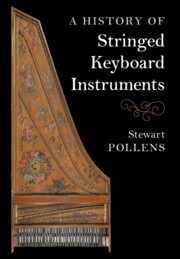Book contents
- A History of Stringed Keyboard Instruments
- A History of Stringed Keyboard Instruments
- Copyright page
- Contents
- Figures
- Tables
- Preface and Acknowledgments
- Pitch Notation Conventions
- One Keyboard Origins
- Two Principles of Design and Construction
- Three The Henri Arnaut Manuscript
- Four The Renaissance
- Five The Baroque Period
- Six The Invention of the Piano
- Seven The Classical Period
- Eight The Romantic Era
- Nine Stagnation and Revival
- Bibliography
- Index
One - Keyboard Origins
Published online by Cambridge University Press: 03 April 2022
- A History of Stringed Keyboard Instruments
- A History of Stringed Keyboard Instruments
- Copyright page
- Contents
- Figures
- Tables
- Preface and Acknowledgments
- Pitch Notation Conventions
- One Keyboard Origins
- Two Principles of Design and Construction
- Three The Henri Arnaut Manuscript
- Four The Renaissance
- Five The Baroque Period
- Six The Invention of the Piano
- Seven The Classical Period
- Eight The Romantic Era
- Nine Stagnation and Revival
- Bibliography
- Index
Summary
This chapter deals with the earliest references to keyboard instruments in the writings of Martin Agricola, Henri Arnaut of Zwolle, Juan Bermudo, Ercole Bottrigari, Antonio de Cabezon, Eberhardus Cersne, Paulus Paulirinus, Hermann Poll, Michael Praetorius, Sesto Tantini, Sebastian Virdung, and others. Described is the earliest depiction of a keyboard instrument appearing in an altarpiece carving in the cathedral of Minden, Germany, as well as the earliest extant keyboard instrument, a clavicytherium made around 1480, now in the Royal College of Music, London. This chapter deals with the origin of such terms as the chekker, clavichordium, clavicembalo, clavicimbalo, clavicymbalum, claviciterium, clavicytherium, clavisimbalum, dulce melos, epinette, manichordium, monochordion, and monocordo. Also considered are the keyboard ranges of early keyboard instruments and the earliest music written for keyboard instruments, such as the Mulliner Book, the Robertsbridge fragment, and the Faenza Codex.
Keywords
- Type
- Chapter
- Information
- A History of Stringed Keyboard Instruments , pp. 1 - 31Publisher: Cambridge University PressPrint publication year: 2022

